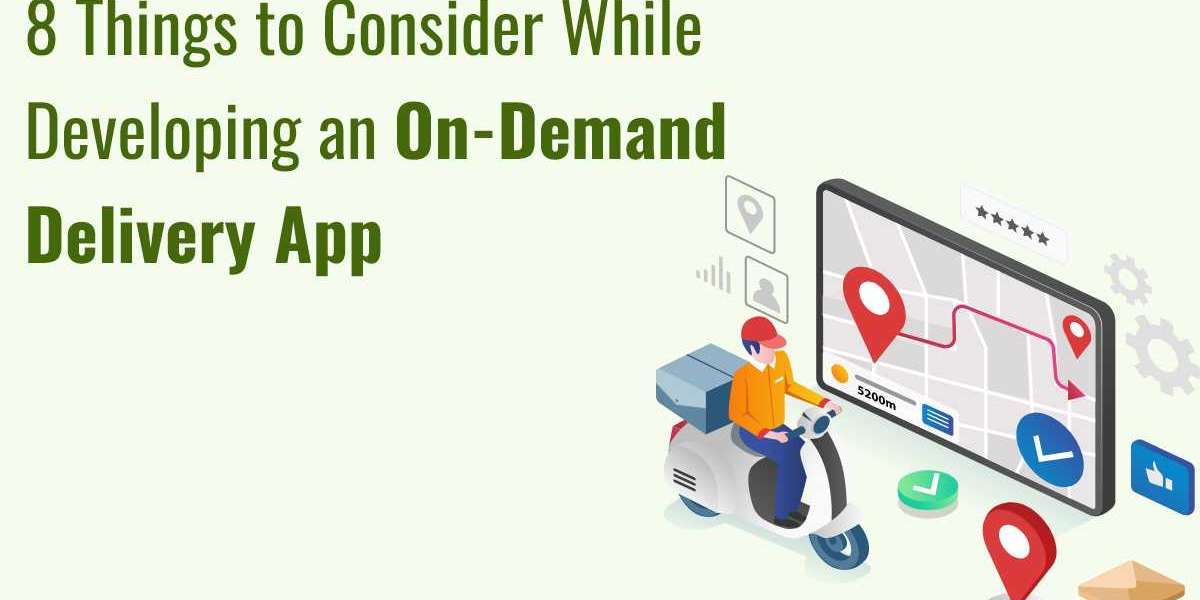The rise of on-demand delivery apps has revolutionized the way businesses operate and how consumers access products and services. Developing an on-demand delivery app requires a strategic approach, careful planning, and a keen understanding of user needs. Here are eight critical considerations to keep in mind during the development process to ensure your app's success.
Understanding Market Needs
Conduct Thorough Market Research
Identify Your Target Audience
Before starting development, it's essential to conduct comprehensive market research to understand your target audience. Identify who your potential users are, their preferences, pain points, and what solutions they currently use. Understanding these elements will help you design a more user-centric app.
Analyze Competitors
Study your competitors to understand what they offer and identify gaps in their services. This analysis can provide insights into features you can incorporate or improve upon to give your app a competitive edge.
Define Your Unique Selling Proposition (USP)
Highlight Your Strengths
Clearly define what sets your app apart from others in the market. Whether it's faster delivery times, lower costs, or unique services, your USP should be compelling enough to attract and retain users.
Communicate Value to Users
Ensure that your USP is communicated effectively to your target audience through marketing and in-app features. This will help in creating a strong brand identity and user loyalty.
Designing an Intuitive User Interface
Focus on User Experience (UX)
Simplified Navigation
A user-friendly interface with simplified navigation is crucial for retaining users. Ensure that the app is easy to navigate, with clear categories and a logical flow that guides users effortlessly from browsing to checkout.
Consistent Design Elements
Maintain consistency in design elements such as fonts, colors, and button styles throughout the app. Consistent design enhances usability and provides a seamless experience for users.
Optimize for Multiple Devices
Responsive Design
Ensure that your app is responsive and works smoothly on various devices, including smartphones and tablets. A responsive design adapts to different screen sizes and provides a uniform experience across all devices.
Cross-Platform Compatibility
Develop your app to be compatible with multiple operating systems, such as iOS and Android. This broadens your reach and makes your app accessible to a wider audience.
Implementing Robust Security Measures
Protect User Data
Secure Payment Gateways
Implement secure payment gateways that protect user financial information. Use encryption protocols such as SSL/TLS to ensure that all transactions are secure.
Data Encryption
Encrypt sensitive user data, including personal information and order details, to prevent unauthorized access and breaches. This builds trust and reassures users about the safety of their data.
Compliance with Regulations
Data Privacy Laws
Ensure that your app complies with relevant data privacy laws such as GDPR, CCPA, or other regional regulations. Obtain necessary user consent and provide clear privacy policies.
Regular Security Audits
Conduct regular security audits and updates to identify and fix vulnerabilities. Staying proactive with security measures can prevent potential breaches and protect user data.
Ensuring Real-Time Tracking and Updates
Live Order Tracking
GPS Integration
Integrate GPS tracking to provide real-time updates on the location of deliveries. This feature enhances transparency and allows users to track their orders in real-time.
Delivery Status Notifications
Send push notifications at each stage of the delivery process, such as order confirmation, dispatch, and delivery. Keeping users informed improves their experience and reduces anxiety.
Accurate Estimated Time of Arrival (ETA)
Dynamic ETA Adjustments
Provide accurate ETAs that adjust dynamically based on real-time factors such as traffic conditions. Accurate ETAs help manage user expectations and enhance satisfaction.
Communicate Delays
If there are any delays, communicate them promptly to users. Transparency in communication helps maintain trust and reduces user frustration.
Offering Multiple Payment Options
Diverse Payment Methods
Credit/Debit Cards and Digital Wallets
Provide a variety of payment options, including credit/debit cards, PayPal, Apple Pay, and Google Pay. Offering multiple payment methods caters to different user preferences and increases conversion rates.
Cash on Delivery (COD)
For regions where digital payments are less common, offer a cash-on-delivery option. This flexibility can attract a broader customer base and improve sales.
Secure Payment Processing
Two-factor authentication (2FA)
Implement two-factor authentication (2FA) for added security during transactions. 2FA provides an additional layer of protection, reducing the risk of fraudulent activities.
Fraud Detection Systems
Incorporate fraud detection systems to monitor and identify suspicious activities. Proactive fraud prevention measures can protect both the business and users.
Efficient Order and Inventory Management
Real-Time Inventory Updates
Sync with Inventory Systems
Integrate your app with inventory management systems to provide real-time updates on product availability. This prevents users from ordering out-of-stock items and enhances their experience.
Automated Alerts
Set up automated alerts for low stock levels to ensure timely restocking. This helps maintain inventory levels and prevents lost sales due to stockouts.
Streamlined Order Processing
Automated Order Management
Automate order processing to reduce manual errors and improve efficiency. Use software to handle order confirmations, dispatches, and deliveries seamlessly.
Delivery Route Optimization
Implement delivery route optimization to reduce delivery times and costs. Efficient route planning can enhance delivery speed and reduce fuel consumption.
Providing Excellent Customer Support
Multi-Channel Support
In-App Chat and Call Support
Offer multi-channel support, including in-app chat and call options. Responsive customer service can resolve issues promptly and improve user satisfaction.
Comprehensive Help Center
Create a comprehensive help center with FAQs, tutorials, and troubleshooting guides. Providing self-service support options can help users find answers quickly and reduce the load on customer support teams.
Collecting and Responding to Feedback
Post-Delivery Feedback
Allow users to provide feedback after their delivery. Collecting feedback helps improve service quality and build credibility.
Responding to Reviews
Respond to customer reviews to show that you value their feedback. Engaging with users can build trust and foster a sense of community.
Leveraging Data and Analytics
User Behavior Analytics
Track User Interactions
Use analytics tools to track user interactions and understand their behavior within the app. Analyzing this data helps in identifying trends and areas for improvement.
Personalize User Experience
Leverage data to provide personalized recommendations and offers. Tailored experiences can enhance user engagement and drive sales.
Performance Metrics
Monitor App Performance
Regularly monitor key performance metrics such as load times, crash rates, and user engagement. This helps in identifying and addressing performance issues promptly.
Use Insights for Improvement
Use insights gained from analytics to make informed decisions about app updates and feature enhancements. Continuous improvement based on data can lead to better user satisfaction and retention.
Conclusion
Developing an on-demand delivery app involves careful planning and consideration of various factors to ensure its success. By understanding market needs, focusing on user experience, implementing robust security measures, providing real-time tracking, offering multiple payment options, ensuring efficient order management, providing excellent customer support, and leveraging data analytics, you can create a comprehensive and effective app.
These best practices and key features will not only enhance user satisfaction but also drive sales and growth for your business. As the demand for on-demand delivery services continues to rise, investing in a well-rounded app with these considerations in mind will position your business for long-term success.






